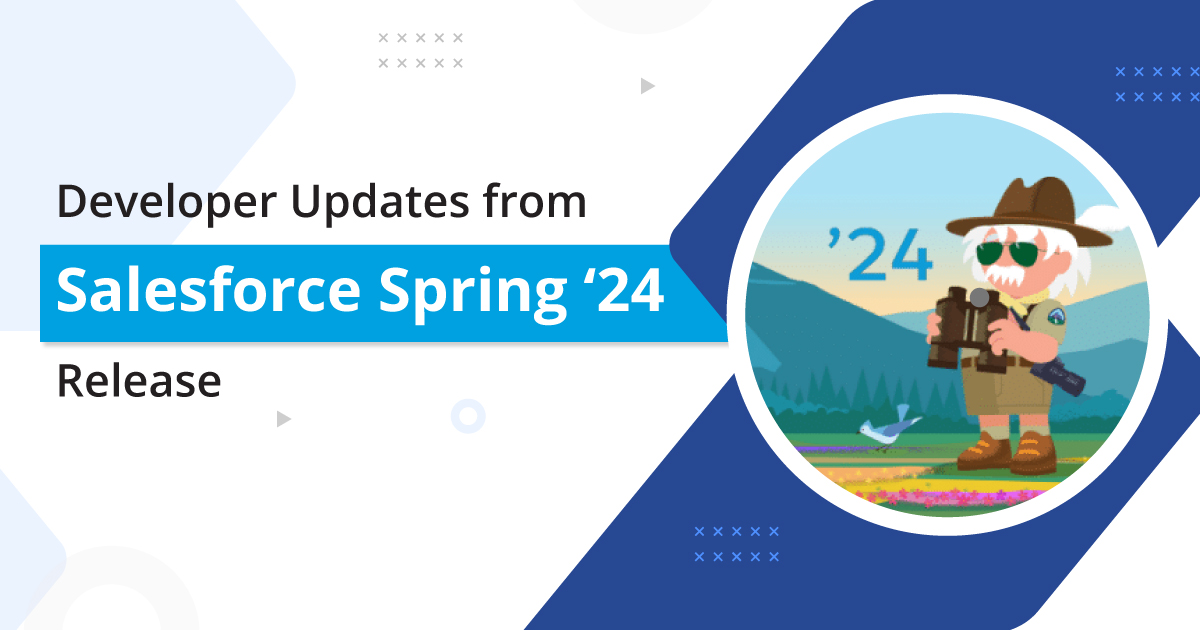Developer Updates from Spring ‘24 Release for Efficient Salesforce Development
06 Feb 2024
Table of Contents

It’s that time of the year when the Salesforce Spring ‘24 release is approaching us, and the first thought that pops up in our mind is how this release would bring wonders for the developers. Salesforce development could be a bit tricky, but with every new release, the developers are able to access new features that could simplify their work while enhancing productivity.
The same is expected from the Spring ‘24 release. We’ve assembled different new developer updates that are expected to transform the way Salesforce development companies have been working.
Table of Contents
Improve Salesforce Development with These Developer Updates
In this blog, we’ll explore the top Salesforce updates from the upcoming release that are going to help Salesforce developers.
1. Migrate to Flow Tool Updated
The Migrate to Flow tool just got even better! Now, it supports partial migration for most actions (excluding invocable actions).
This means you have the flexibility to migrate just what you need. Plus, the migration results will clearly flag any actions needing additional configuration in Flow Builder. This will help achieve seamless migration and simplified workflows.
2. Enhancements in Lightning Web Components
Lightning Web Components just got a boost with several enhancements and new features for Salesforce developers. Now, in the lightning-datatable component, you’ll find the handy wrap-table-header attribute, making header text wrap within column widths for better readability. Additionally, you’ll also get dynamic data types with support for a custom data source component.
3. Access Data Cloud – Triggered Flows
Developers at any Salesforce development company would now be able to work with the new Data Cloud- Triggered flow for debugging in the Flow Builder. This helps in two aspects- conducting the testing of flow behavior and providing the needed assistance in troubleshooting any issues.
With this update, users would be able to manage the flow execution without affecting the real data. This ultimately helps to make sure that the flow works the way it was expected before the deployment.
4. Enhanced Security of Visualforce JavaScript Remoting API
With the new Spring ‘24 release, Salesforce development companies will find a boost in the security associated with the Visualforce JavaScript Remoting API. This is made possible with the JsonAccess annotation in Apex classes. This helps to ensure that no unauthorized user can change your data or move it around.
This update can be very helpful as it not only safeguards the Apex classes from unauthorized access but also ensures there is no sneaky attempt to move your data across different platforms. To use this feature efficiently, users need to select the Data Cloud- Triggered flow they want to work with after navigating to Flow Builder.
What We Did for Our Client
We helped one of our clients from the real estate sector to implement Salesforce and improve their operations. The client is the leader of a renowned real estate investment company that owns and operates recreational vehicles and prefabricated housing parks. The company is privately operated.
Challenges they faced
The team was still relying on outdated legacy methods like using Excel sheets to record client information and update records manually. They needed a stable and reliable platform to manage the data. So, they were looking for a more reliable medium for their offshore teams to interact with customers and their data. This was time-consuming and inconsistent and needed modification.
They came to us to create a more accessible and systematic interaction system for customer-facing teams. Their data storage system also needed to be upgraded to handle large volumes of customer data.
How we helped
Optimized Salesforce for organized data storage and consistency
The company mainly aimed at optimizing the use of their Salesforce in a more judicious way. We set up a Salesforce entity or Org that contained a username and information of the client. This was a safe and reliable option to store the client data without any inconsistency.
Automatic data updates in all synced sheets
For all the existing client information, we shared a common spreadsheet template that helped sync all other attached templates. Doing this, changes made to one template would automatically update the others.
Effective Follow-ups
The updated reports were sent to the client on a weekly basis and then were passed on to the outsourced sales team by the client. The spreadsheets were used as a contact sheet that included all client information and relevant data.
Convenient data migration and sharing
The data needed to be imported into the lead object to avoid any information leak. The existing data was important to migrate into the current system and with the right measures.
Reported outcomes
Here’s what we helped our client achieve:
– A 360-degree view of client data enabled easy tracking of required records and lowered the chances of reputational loss.
– Regular follow-ups with clients made it easier to collect their opinions and improvise where required and made customers more inclined to respond through personalized interactions.
– Centralized agent and estate data led to a reliable database without inconsistencies. Agents could access the information centrally and clear customer objections, if any.
– Automatic updates were pushed to all sheets. Also, the automatic recording of information leaves minimum chances of gaps in customer profiles.
Hire Certified Experts for Salesforce Development
Salesforce comes up with three major releases every year, and with each release, it never fails to impress us. With the Spring ‘24 release, we are already waiting for such amazing features that could transform the way Salesforce developers have been working. It’s not just about simplifying the experience but also to enhance the quality of work and productivity.
Being Salesforce experts for over 11 years, we’ve been helping multiple clients across different industries to leverage the power of CRM and transform their operations. Our certified Salesforce professionals will help analyze your operations and implement a customized Salesforce solution that can align perfectly with your business goals. Contact us to get your operations analyzed for an upgrade that will lead to enhanced productivity and efficiency.
About the author
Editorial Team – 360 Degree CloudThe Editorial Team at 360 Degree Cloud brings together seasoned marketers, Salesforce specialists, and technology writers who are passionate about simplifying complex ideas into meaningful insights. With deep expertise in Salesforce solutions, B2B SaaS, and digital transformation, the team curates thought leadership content, industry trends, and practical guides that help businesses navigate growth with clarity and confidence. Every piece we publish reflects our commitment to delivering value, fostering innovation, and connecting readers with the evolving Salesforce ecosystem.
Recent Blogs
 Industry
Industry
Salesforce for Professional Services: Why It’s a Must-Have for Modern Firms
The entire professional services industry, whether it is legal or IT, has always been struggling with tremendous operational challenges. On one hand, there is the…
Read More Salesforce Services
Salesforce Services
How Salesforce Managed Services Optimizes Your Licenses
For many organizations, the annual Salesforce renewal process feels less like a strategic investment and more like a mandatory expense hike. The harsh truth is…
Read More Salesforce Clouds
Salesforce Clouds
Top 10 Salesforce Integration Tools to Connect Your Tech Stack
Gone are those days when businesses used to rely on one or two systems to manage their operations. In this modern tech ecosystem, businesses use…
Read MoreReady to Make the Most Out of Your Salesforce Instance?
Our Salesforce aces would be happy to help you. Just drop us a line at contact@360degreecloud.com, and we’ll take it from there!
Subscribe to our newsletter
Stay ahead with expert insights, industry trends, and exclusive resources—delivered straight to your inbox.



